Trying to decide between an electric scooter and an electric bike? It's a common dilemma, but the core difference is pretty straightforward. E-scooters are all about ultimate portability for those short, last-mile city trips, while e-bikes deliver better comfort, range, and versatility for longer commutes. Your decision really boils down to whether you need maximum convenience or all-around capability.
E-Scooter vs E-Bike The Quick Answer
Picking between these two popular electric rides really depends on how you see yourself getting around day-to-day. An electric scooter is the king of "grab-and-go" travel. It's the perfect companion for a mixed commute where you might need to jump on public transit. They’re often foldable and compact, making them a breeze to stash under your desk at work or tuck away in a small apartment.
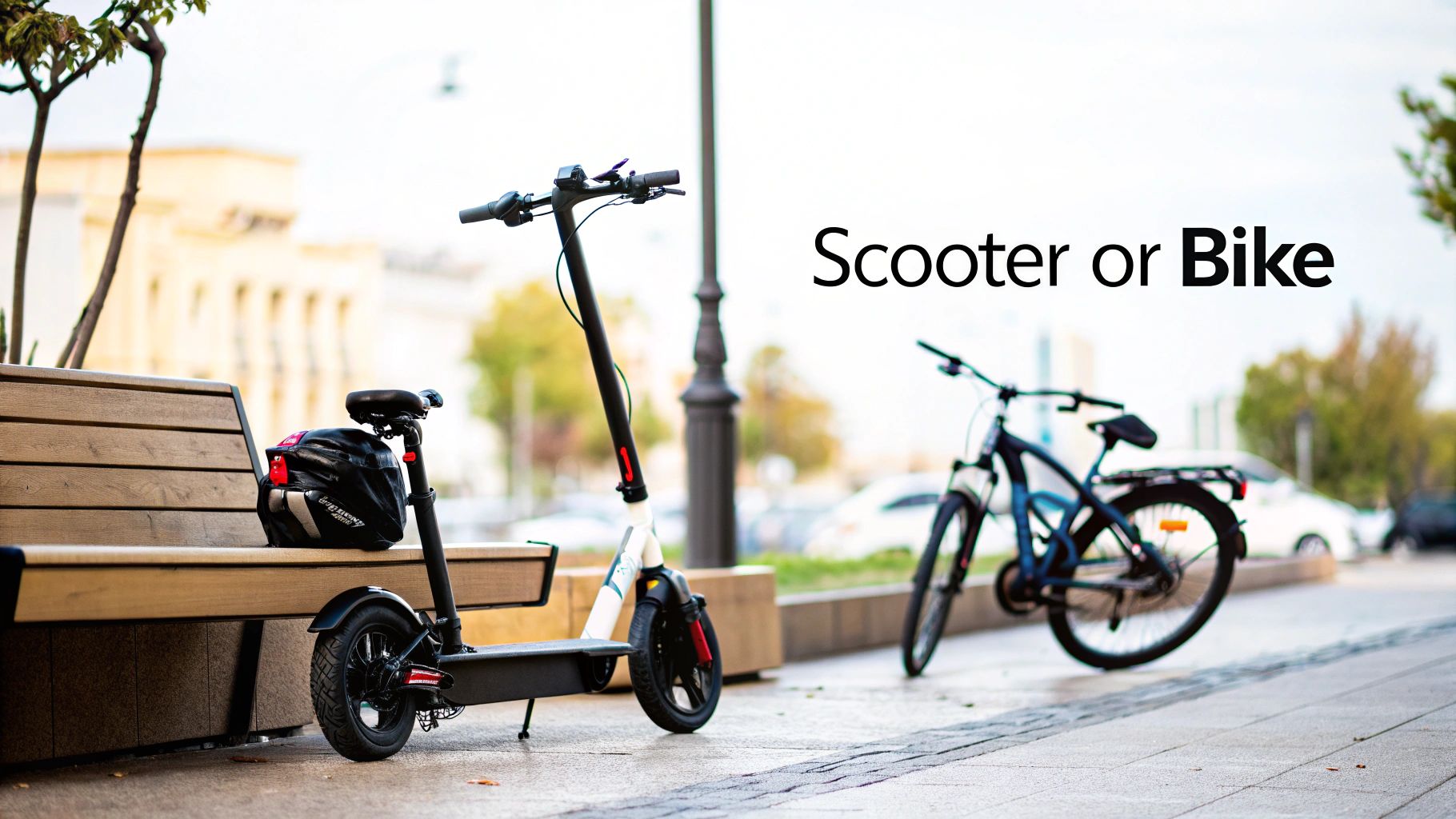
On the flip side, an electric bike feels much more like a traditional bicycle, just with a welcome power boost. It's designed for the long haul, easily handling steep hills and different types of terrain. The bigger wheels and sturdier frame give you a much smoother, more stable ride, which is a huge plus on some of the less-than-perfect roads you find across the US and Australia.
So, what are the real trade-offs? Let's break it down.
- Portability: E-scooters are way lighter and more compact. No contest.
- Comfort: E-bikes, with their big wheels and proper saddles, win on comfort every time, especially on longer rides.
- Range: Generally, e-bikes pack larger batteries, which means you can go a lot further on a single charge.
- Exercise: An e-bike gives you the option to pedal, so you can get a workout in. A scooter is a purely passive ride.
The question of whether electric bikes are worth it often comes down to these points, as they beautifully blend transport with light exercise.
At the end of the day, if you just need to cover that last mile from the station to the office, an e-scooter is a brilliant choice. But if you’re after a ride that can handle your entire commute, help with the grocery run, or take you on a leisurely weekend adventure, an e-bike is the clear frontrunner.
At a Glance Key Differences Between E-Scooters and E-Bikes
To make things even clearer, here’s a quick table to help you compare the two side-by-side. It lays out the fundamental differences to guide your decision.
| Feature | Electric Scooter | Electric Bike |
|---|---|---|
| Best For | Short, "last-mile" urban trips and multi-modal commutes. | Longer commutes, exercise, and varied terrain. |
| Portability | High – often foldable and lightweight. | Low – bulkier and heavier. |
| Comfort | Moderate – smaller wheels feel bumps more. | High – larger wheels and saddle absorb shock. |
| Typical Range | 10-25 miles (16-40 km). | 25-60+ miles (40-97+ km). |
| Exercise | Minimal – passive standing ride. | Yes – pedal-assist allows for a workout. |
| Legality (US) | Varies by state and city; widely accepted. | Generally legal, with class systems (1, 2, 3). |
| Storage | Easy – fits under a desk or in a closet. | Requires dedicated space like a regular bike. |
Ultimately, both are fantastic ways to get around, but they excel in very different scenarios. Use this breakdown to match your daily needs with the right set of wheels.
Comparing Performance and Ride Experience
Forget the spec sheets for a second. The real story in the electric scooter vs. electric bike showdown is how they feel to ride. These two options are worlds apart, and that difference shapes everything from your daily comfort to how you get around town.
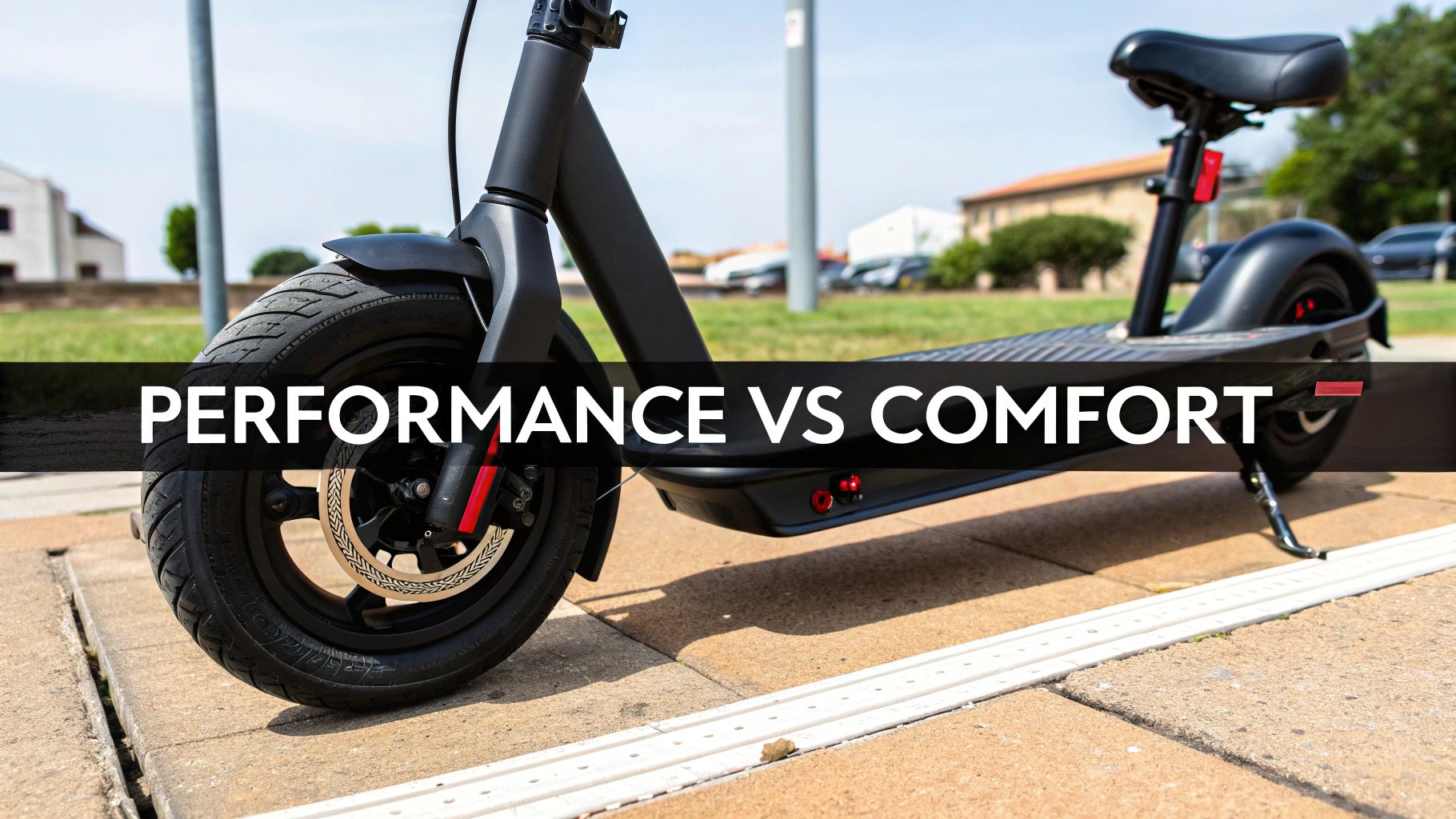
An electric scooter gives you that instant, zippy feeling. You push a thumb throttle, and whoosh—you're off. It’s a fun, almost playful burst of speed that’s perfect for weaving through slow city traffic or getting a jumpstart when the light turns green.
Electric bikes, on the other hand, deliver a much more gradual, powerful assist. The motor doesn't jolt you forward; it blends with your pedaling to make you feel like you've suddenly got superhuman legs. It’s less of a sudden launch and more like having a consistent tailwind, especially when you hit a hill that would leave you gasping on a regular bike.
The Portability and Convenience Factor
Here's where the two really go head-to-head: portability. An e-scooter is built for what we call "multi-modal" travel. You ride it, fold it, and carry it. Most models collapse in a few seconds and are light enough to bring on the train or stash under your desk at work. This grab-and-go design is a game-changer if your commute involves a mix of riding and public transport.
E-bikes just can't compete here. They're bigger, heavier, and way more awkward to haul around. Sure, folding e-bikes exist, but even they are pretty cumbersome. With a full-sized e-bike, you're constantly thinking about where you're going to securely lock it up—a problem scooter riders almost never have.
The core trade-off is simple: E-scooters give you incredible portability but sacrifice ride comfort. E-bikes offer a much smoother, more comfortable ride but require a lot more effort to store and transport.
Comfort and Handling on Real-World Roads
When it comes to pure ride quality, the e-bike wins, hands down. Its large wheels and classic bicycle frame just handle bumps, potholes, and cracked pavement so much better than an e-scooter's tiny, often solid wheels. A ride on an e-bike feels stable, planted, and smooth, which gives you a ton of confidence on longer trips or rougher roads.
E-scooters, in contrast, can feel pretty shaky on anything less than perfect asphalt. You feel every single crack and pebble. While many higher-end scooters now come with suspension to help smooth things out, they still can't really match the natural shock absorption you get from an e-bike's big air-filled tires and frame design. If your route is bumpy, you'll be much happier on an e-bike.
If you want to dig deeper into specific models and features, you can compare electric scooter options in our detailed guide.
A Look at Range and Battery Realities
Take manufacturer range claims with a huge grain of salt. They’re usually based on a perfect scenario: a lightweight rider on a perfectly flat road with zero wind. The real world is full of hills, stop-and-go traffic, and different rider weights, all of which chew through your battery.
Generally speaking, e-bikes have the edge in range. They simply have bigger batteries, and the fact that you’re pedaling helps conserve a ton of power. It's not uncommon to get a real-world range of 25-60+ miles (40-97+ km) from an e-bike.
Electric scooters have smaller batteries and rely 100% on the motor, so their range is naturally shorter. You're typically looking at around 10-25 miles (16-40 km). That’s plenty for most "last-mile" commutes but might feel a bit limiting if you're planning a longer adventure.
These different strengths have shaped how popular each one is. The whole electric two-wheeler market is exploding, with global sales hitting 4.4 million units in just the first half of a recent year. While e-scooters have become a massive hit in dense Asian cities, e-bikes have found a broader audience across the globe for both commuting and recreation, thanks to their health and environmental upsides. The choice really boils down to what you need your ride to do.
E-Scooter vs. E-Bike Laws: What You Need to Know in the US and Australia
Before you pull the trigger on an electric scooter or an e-bike, you absolutely have to get your head around the local laws. It’s a bit of a minefield, and the rules can change dramatically from one state—or even one city—to the next. Getting this wrong isn't a slap on the wrist; it can mean hefty fines or watching your shiny new ride get impounded.
In the United States, there is no single federal law governing e-scooters and e-bikes. Instead, it's a patchwork of state and local regulations. Generally, personal mobility devices are widely accepted, but specifics on speed, age limits, and where you can ride vary significantly.
For example, California classifies e-scooters as motorized scooters, requiring a driver's license and helmet use, with a speed limit of 15 mph. In contrast, Florida treats them more like bicycles, with no license requirement for riders over 16. It is crucial to check your specific state and city ordinances before you ride.
This decision tree gives a great visual breakdown of the legal landscape for e-scooters and e-bikes, comparing common US and Australian approaches.
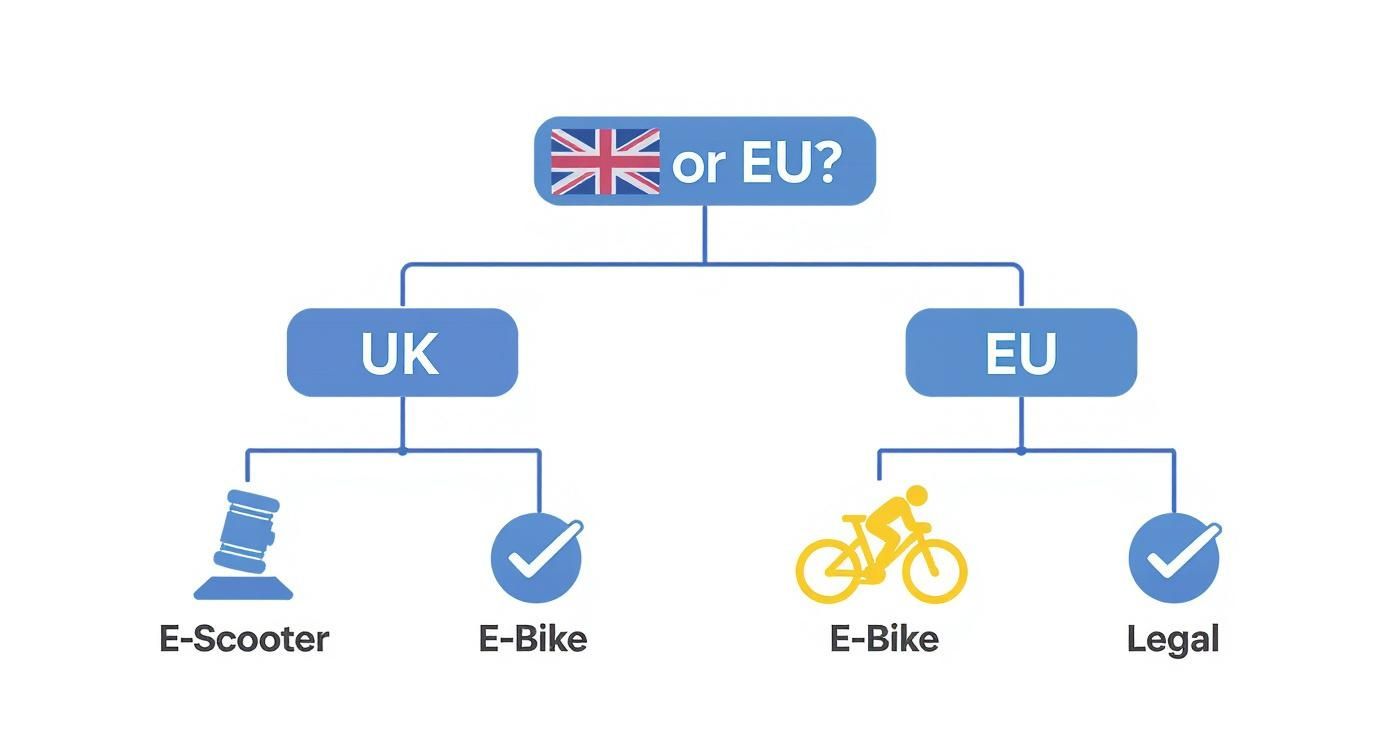
As you can see, both e-scooters and e-bikes have found a legal footing in most places, but the devil is in the details of local regulations.
US E-Bike Rules: Understanding the Class System
Thankfully, electric bike laws in the US are becoming more standardized thanks to a three-class system that many states have adopted. This system makes it easier to understand what's legal.
To be considered a legal e-bike, it must fit into one of these classes:
- Class 1: Pedal-assist only (no throttle), with a maximum assisted speed of 20 mph.
- Class 2: Can be propelled by a throttle, with a maximum motor-powered speed of 20 mph.
- Class 3: Pedal-assist only, with a maximum assisted speed of 28 mph (often requires riders to be 16+ and wear a helmet).
If your e-bike fits into one of these classes, you can generally ride it where regular bikes are allowed. However, local rules can still restrict certain classes from multi-use paths or trails, so always check first.
How Australia Handles E-Scooters and E-Bikes
Down under, the laws are also set at the state and territory level, leading to a variety of rules. Australia has a national standard for 'power-assisted pedal cycles,' similar to the US e-bike classes. These bikes must have a motor of 250 watts or less (for pedal-assist) or 200 watts (for throttle-controlled), and the motor must cut out at 25 km/h (15.5 mph).
The bottom line is this: while both the US and Australia are embracing electric mobility, the responsibility is on the rider to know and follow local laws. What's perfectly legal in one city could get you a ticket in the next.
E-scooter laws in Australia are more varied. Some states, like Queensland and Australian Capital Territory (ACT), have legalized them with specific rules (e.g., speed limits of 25 km/h on paths). Other states, like New South Wales, are still in trial phases and restrict private e-scooter use to private property only.
If you want to get into the weeds on how speed limits work, our guide on the electric scooter speed limit breaks it down further.
Ultimately, where you live is probably the biggest factor in the electric scooter vs. electric bike debate. In most parts of the US and Australia, you've got a real choice, but you'll still need to do a quick check of the local regulations to ride legally and safely.
Choosing Your Ride for Real-World Scenarios
Picture your day from start to finish—no spec sheets, just your actual life. We’ll walk through everyday moments to see whether a scooter or a bike becomes your daily sidekick.
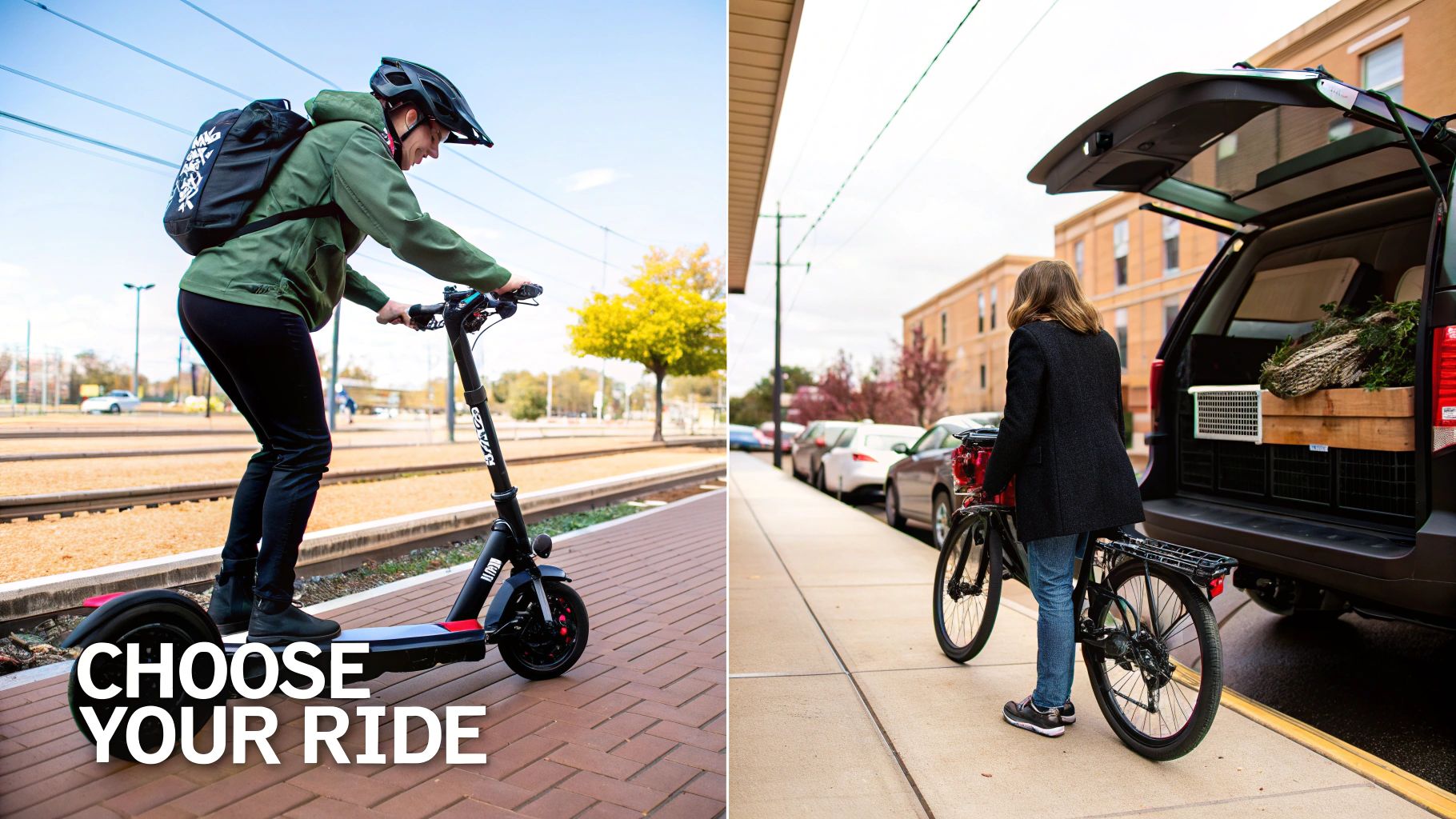
Context is everything. One option zips you past traffic snarls; the other hauls your groceries without breaking a sweat.
The Multi-Modal Commute
Imagine living a stone’s throw from the train station, hopping on for a 30-minute ride, then tackling that last mile to the office. For this trip, the electric scooter is an absolute game-changer.
- Fold in under 10 seconds
- Carry onto the train with ease
- Unfold and ride off to work
Hauling an e-bike through packed carriages? Not happening. Here, the scooter’s grab-and-go agility is unbeatable.
Suburban Errands And Grocery Runs
Now swap to a Saturday morning grocery run in your neighborhood. The electric bike takes the crown.
- Clip on panniers or a rear rack
- Smoothly handle uneven sidewalks
- Carry multiple bags without wobble
An e-scooter’s tiny deck and lack of storage quickly turn a simple errand into a balancing act—and a safety risk.
Hilly Cities And Rough Roads
Daily route a mix of steep hills and cracked pavement? This is where e-bikes shine. Their pedal-assist motors kick in exactly when you need them, making climbs almost effortless.
Scooters, with smaller motors and wheels, can grind to a crawl uphill and drain batteries fast. Plus, you’ll feel every bump on rough streets.
Globally, e-bike sales soared to 41.68 million units in a recent year, outpacing private e-scooter ownership by a wide margin. Check out the global e-bike and e-scooter market on Statista.com for more data on how riders pick their wheels by real-world need.
Below is a quick reference to help you decide at a glance which ride suits your scenario.
Which Ride for Which Scenario
| Scenario | Best Choice | Why It Works Best |
|---|---|---|
| Short, Mixed Commute | Electric Scooter | Easy folding and hassle-free public transport use |
| Grocery Runs & Errands | Electric Bike | Superior cargo capacity and ride stability |
| Hilly Terrain & Uneven Roads | Electric Bike | Pedal-assist power and larger wheels smooth the journey |
Use this as your cheat sheet when weighing options—so you make a choice that fits your daily ride, not just the spec sheet.
Calculating the True Cost of Ownership
The sticker price is just the start of the story. When you're trying to decide between an electric scooter and an electric bike, you have to look at the total cost over a few years to get the real picture. E-scooters almost always look cheaper upfront, but the true value becomes clear once you add up everything from charging and repairs to what it's worth when you sell it.
Of course, that initial purchase is the biggest single hit to your wallet. Both e-scooters and e-bikes have a huge price range, but as a general rule, scooters are the more budget-friendly option to get started.
- Budget Models: You can grab a decent entry-level e-scooter for around $300-$500. A comparable e-bike? You’re usually looking at a starting point closer to the $800-$1,300 range.
- Mid-Range Options: Step up to a mid-range scooter for better performance and you’ll spend $500-$900. A mid-range e-bike jumps to $1,300-$2,500, but that gets you bigger batteries and much better components.
- Premium Rides: The best e-scooters can push past $1,000, while top-tier e-bikes can easily soar beyond $3,000, packing in some seriously advanced tech.
That initial price gap often makes a scooter seem like a no-brainer. But your spending doesn't stop the moment you leave the store.
Ongoing and Hidden Expenses
Beyond that first payment, other costs will creep in. The good news is that charging either one is dirt cheap—we’re talking pennies per charge. Where the costs really start to differ is in maintenance and gear.
E-bikes are basically bicycles with a motor, which means they have all the same moving parts: chains, gears, and derailleurs. These bits need regular love, like chain lubrication, gear tuning, and eventually, replacement. E-scooters are much simpler machines, usually just needing the occasional brake check and air in the tires.
The real financial game-changer over time isn't the cost of electricity—it's the maintenance and resale value. An e-bike's higher price tag can be balanced out by its sheer durability and how well it holds its value.
Don't forget the gear, either. A good helmet is non-negotiable for both. But you'll probably want a heavy-duty, expensive lock for an e-bike, as they're a much juicier target for thieves. Scooter owners can often get by with something a bit more portable, but security is an investment you can't skip.
Resale Value and Long-Term Worth
This is where that pricier e-bike can really start to make financial sense. The e-bike market is absolutely booming, thanks to people wanting greener, healthier ways to get around. In fact, market projections show the global e-bike market is expected to hit a staggering USD 45.5 billion by 2033, growing at a steady clip of 6.22% each year. You can check out more on the booming e-bike market on futuremarketinsights.com.
What does that mean for you? All that demand helps e-bikes hold their value incredibly well. E-scooters, with their simpler builds and often shorter lifespans, tend to depreciate much faster.
So, when it's time to upgrade, you’re likely to get a much bigger chunk of your money back from an e-bike. While an e-scooter saves you cash on day one, an e-bike often turns out to be the smarter long-term asset. Once you do the math on the true cost of ownership, that initial price difference doesn't seem so big after all.
Got a Few More Questions?
You've crunched the numbers on performance and cost, and you've pictured how each ride fits into your daily life. But maybe there are still a few nagging questions bouncing around in your head. Let's clear those up so you can make your final call.
E-Bike or E-Scooter: Which One Is Better for Fitness?
If you're looking to sneak a workout into your commute, the electric bike wins this one, no contest.
Think about it: riding an e-scooter is pretty much a passive activity. You stand, you balance (which engages your core a little, I'll give you that), and you go. An e-bike, on the other hand, is still a bicycle at its heart. You have to pedal.
The motor is there to assist you, not do all the work. You can dial that assistance down for a serious cardio burn or crank it up to get you over a beast of a hill without feeling like you've just run a marathon. You're always in control of how much effort you put in.
How Much Upkeep Are We Talking About?
When it comes to maintenance, e-scooters are generally the simpler and cheaper option. The main components are the battery, motor, brakes, and tires. Your to-do list is pretty short: keep the tires pumped, check the brakes, and be smart about charging the battery.
E-bikes have all that plus everything that comes with a standard bike. We're talking about a chain, gears, pedals, and a derailleur. All those parts need regular cleaning, oiling, and eventually, some tuning or even replacement. That extra complexity naturally means a bit more time and money spent on maintenance over the long haul.
It really just boils down to the number of moving parts. The e-scooter’s straightforward design means less can go wrong, while the e-bike’s cycling DNA requires a bit more old-school TLC.
Can I Ride These in the Rain?
Yes, but you need to be smart about it. Most decent e-scooters and e-bikes today have an IP (Ingress Protection) rating, which gives you an idea of how water-resistant they are. This means they can usually handle a light drizzle without shorting out.
However, neither of them is a submarine. Riding through a torrential downpour or plowing through deep puddles is a great way to fry expensive electronics. E-bikes sometimes have a slight edge here, as their critical parts tend to sit higher off the ground and are often better protected.
No matter which you're riding, wet weather changes the game entirely:
- Braking takes way longer. Seriously, give yourself double the stopping distance you normally would.
- Your grip on the road disappears. Wet pavement, manhole covers, and painted lines become ice rinks.
- Nobody can see anything. Be extra cautious and assume cars and pedestrians don't see you.
Always check the IP rating and what the manufacturer recommends before you even think about heading out into a storm.
Which Is Easier to Learn?
If you know how to ride a bike, you already know how to ride an e-bike. It feels exactly the same, just with a helpful push. There's basically zero learning curve.
An e-scooter is a slightly different beast for a total beginner. You have to find your balance on a narrow deck while getting the hang of a thumb throttle and brake levers. It’s a new skill, not just an enhanced old one.
That being said, most people get the hang of an e-scooter within 15 to 30 minutes of goofing around in an empty parking lot. The initial wobbles fade fast, and soon enough, you’re zipping around with confidence. While the e-bike is more instantly familiar, both are incredibly easy to pick up.
Ready to find the perfect ride that fits your life? At Punk Ride LLC, we’ve curated a top-tier selection of electric scooters and electric bikes from leading brands. Whether you need the quick convenience of a scooter or the versatile power of an e-bike, we have the ride that will transform your commute.
Explore our collection and start your next adventure today at https://www.punkride.com.




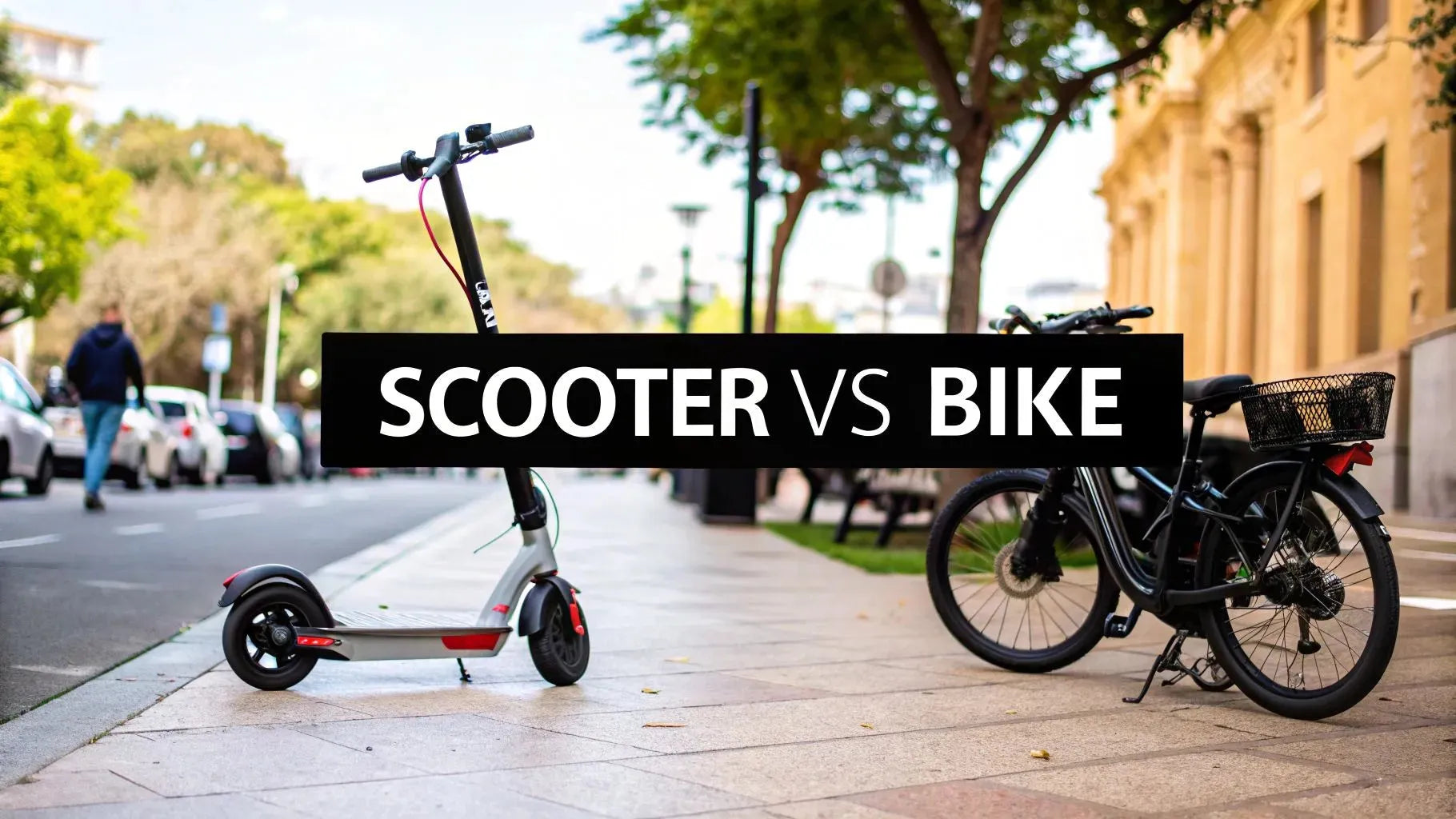
Share:
Your Guide to Electric Bikes for Urban Commuting
Understanding Electric Bike Weight Limits